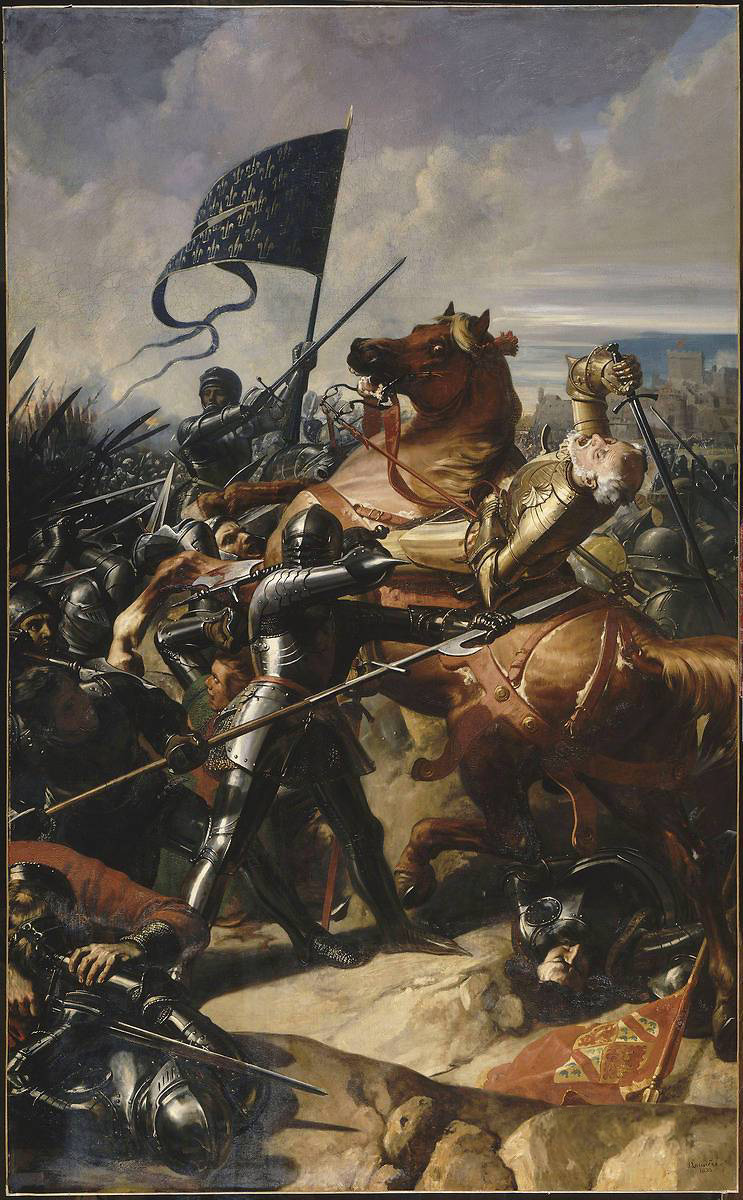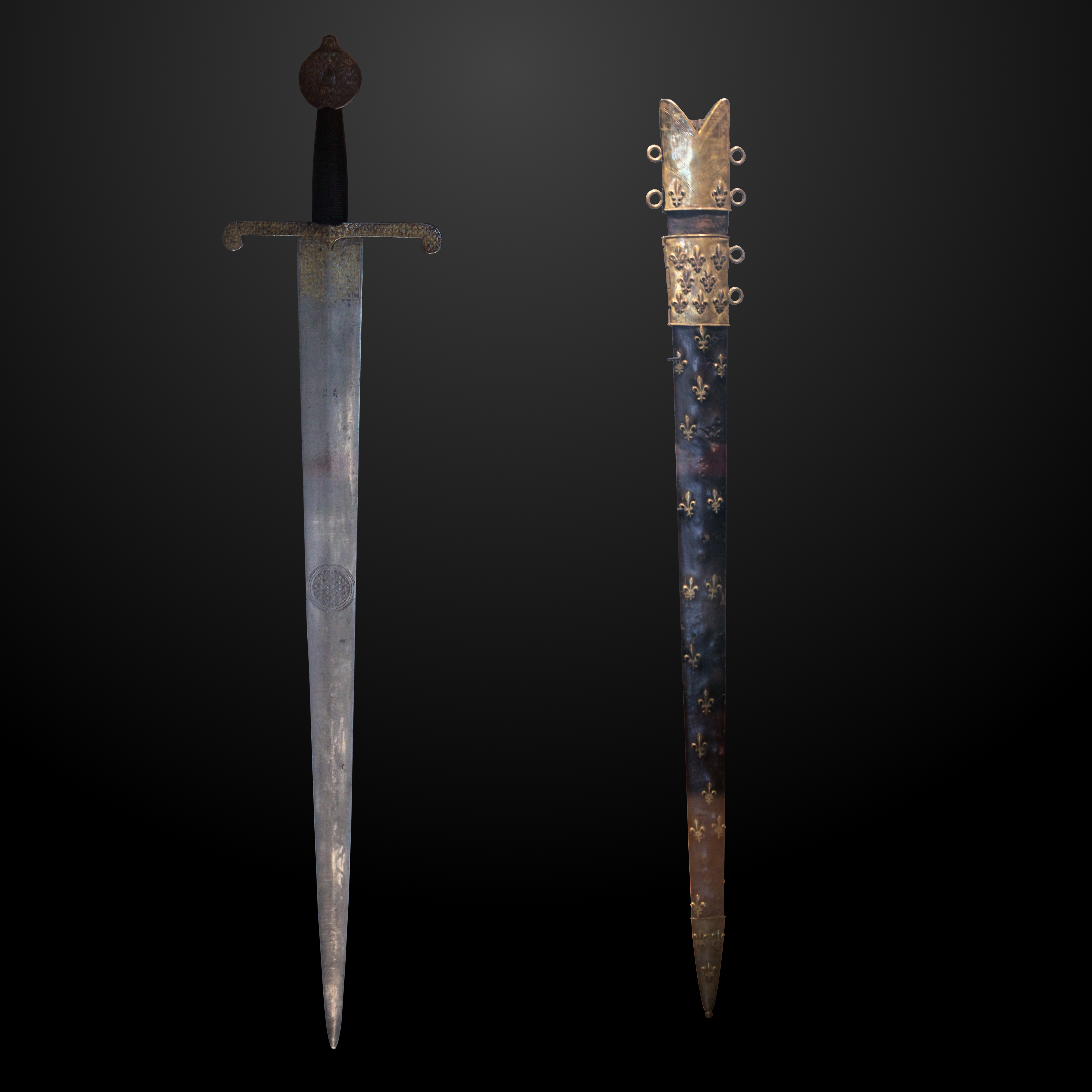|
Sire De Bourbon
The Sire de Bourbon or Seigneur de Bourbon, meaning Lord of Bourbon, was the title by which the rulers of the Bourbonnais were known, from 913 to 1327, and from which the cognomen of the royal House of the same name derives. Louis I, count of Clermont, the ultimate holder, was created the first "Duke of Bourbon" and made " count of La Marche" by his cousin, King Charles IV of France, in exchange for Clermont-en-Beauvaisis, thus absorbing the title. This title dates to at least the early 10th century and Aymar de Bourbon. Aymar lived under the reign of the Carolingian overlord Charles III of France who gave to him, in the year 913, several strongholds on the river Allier, such as the castle in the medieval town of Bourbon-l'Archambault. Of Aymar's ten successors all but three took the name "Archambault". His line ended in 1200 with the death of Archambaud VII, whose granddaughter, Mathilde of Bourbon, then became the first ''dame de Bourbon'' (''dame'' being the feminine form ... [...More Info...] [...Related Items...] OR: [Wikipedia] [Google] [Baidu] |
Title
A title is one or more words used before or after a person's name, in certain contexts. It may signify either generation, an official position, or a professional or academic qualification. In some languages, titles may be inserted between the first and last name (for example, ''Graf'' in German, Cardinal in Catholic usage (Richard Cardinal Cushing) or clerical titles such as Archbishop). Some titles are hereditary. Types Titles include: * Honorific titles or styles of address, a phrase used to convey respect to the recipient of a communication, or to recognize an attribute such as: ** Imperial, royal and noble ranks ** Academic degree ** Social titles, prevalent among certain sections of society due to historic or other reasons. ** Other accomplishment, as with a title of honor * Title of authority, an identifier that specifies the office or position held by an official Titles in English-speaking areas Common titles * Mr. – Adult man (regardless of marital status) ... [...More Info...] [...Related Items...] OR: [Wikipedia] [Google] [Baidu] |
Bourbon-l'Archambault
Bourbon-l'Archambault is a spa town and a commune in the Allier department in Auvergne-Rhône-Alpes region in central France. It is the place of origin of the House of Bourbon. Population Personalities In 1681, Louise Marie Anne de Bourbon, ''Mademoiselle de Tours'' - the third daughter of Louis XIV and his mistress Françoise-Athénaise, Madame de Montespan - died there at the age of six. On 26 May 1707, Madame de Montespan herself also died at the chateau. The town was Charles Maurice de Talleyrand-Périgord's favorite vacation spot. In 1915, mathematician André Lichnerowicz was born here (died 1998). See also *Communes of the Allier department *Bourbonnais *Borvo *House of Bourbon The House of Bourbon (, also ; ) is a European dynasty of French origin, a branch of the Capetian dynasty, the royal House of France. Bourbon kings first ruled France and Navarre in the 16th century. By the 18th century, members of the Spanis ... References * External links Tow ... [...More Info...] [...Related Items...] OR: [Wikipedia] [Google] [Baidu] |
Nevers
Nevers ( , ; la, Noviodunum, later ''Nevirnum'' and ''Nebirnum'') is the prefecture of the Nièvre department in the Bourgogne-Franche-Comté region in central France. It was the principal city of the former province of Nivernais. It is south-southeast of Paris. History Nevers first enters written history as Noviodunum, a town held by the Aedui at Roman contact. The quantities of medals and other Roman antiquities found on the site indicate the importance of the place, and in 52 BCE, Julius Caesar made Noviodunum, which he describes as in a convenient position on the banks of the Loire, a depot (''B. G.'' vii. 55). There, he had his hostages, corn and military chest, with the money in it allowed him from home for the war, his own and his army's baggage and a great number of horses which had been bought for him in Spain and Italy. After his failure before Gergovia, the Aedui at Noviodunum massacred those who were there to look after stores, the negotiators and the traveller ... [...More Info...] [...Related Items...] OR: [Wikipedia] [Google] [Baidu] |
Maud Of Dampierre
Matilda II, Countess of Nevers (1234/35–1262), also known as Maud of Dampierre or Mathilda II of Bourbon, was a sovereign Countess of Nevers, Countess of Auxerre, Countess of Tonnerre. Matilda was a daughter of Archambaud IX of Bourbon and Yolande de Châtillon, Countess of Nevers. As heiress to the counties of Nevers, Auxerre and Tonnerre, she was married off to Odo, the eldest son of Hugh IV, Duke of Burgundy. This marriage was meant to reunite two important counties with the Duchy of Burgundy, but he predeceased his father, and so the duchy passed to his brother Robert II. The county of Nevers was partitioned(Nevers, Tonnerre, Auxerre) among her daughters over the period of ten years. With Odo, Matilda had four daughters: *Yolande, Countess of Nevers (1247–1280), married (1) John Tristan, Count of Valois, and (2) Count Robert III of Flanders * Margaret, Countess of Tonnerre (1250–1308), married King Charles I of Naples * Adelaide, Countess of Auxerre (1251–1 ... [...More Info...] [...Related Items...] OR: [Wikipedia] [Google] [Baidu] |
Archambaud IX Of Bourbon
Archambaud IX of Bourbon (died 15 January 1249), called "''Le Jeune''" ("The Young"), was a ruler (sire) of Bourbonnais in the modern region of Auvergne, France. He was the son of Archambaud VIII of Bourbon. He married Yolande I, Countess of Nevers. They had: * Matilda II, Countess of Nevers (d. 1262) * Agnes, Lady of Bourbon (1237 - 7 September 1288); married Jean of Burgundy, Count of Charolais, the son of Hugh IV, Duke of Burgundy Hugh IV of Burgundy (9 March 1213 – 27 or 30 October 1272) was Duke of Burgundy between 1218 and 1272 and from 1266 until his death was titular King of Thessalonica. Hugh was the son of Odo III, Duke of Burgundy and Alice de Vergy. Issue Hug .... He died in Cyprus on 15 January 1249 ''en route'' to Egypt in support of the Seventh Crusade. See also * House of Dampierre * French Wikipedia article on House of Dampierre References Sources * * * * 1249 deaths House of Dampierre Christians of the Seventh Crusade Year of birth ... [...More Info...] [...Related Items...] OR: [Wikipedia] [Google] [Baidu] |
Military History Of France
The military history of France encompasses an immense panorama of conflicts and struggles extending for more than 2,000 years across areas including modern France, Europe, and a variety of regions throughout the world. According to historian Niall Ferguson, France is the most successful military power in history. It participated in 50 of the 125 major European wars that have been fought since 1495; more than any other European state. The first major recorded wars in the territory of modern-day France itself revolved around the Gallo-Roman conflict that predominated from 60 BC to 50 BC. The Romans eventually emerged victorious through the campaigns of Julius Caesar. After the decline of the Roman Empire, a Germanic tribe known as the Franks took control of Gaul by defeating competing tribes. The "land of Francia", from which France gets its name, had high points of expansion under kings Clovis I and Charlemagne, who established the nucleus of the future French state. In the Mi ... [...More Info...] [...Related Items...] OR: [Wikipedia] [Google] [Baidu] |
Constable Of France
The Constable of France (french: Connétable de France, from Latin for 'count of the stables') was lieutenant to the King of France, the first of the original five Great Officers of the Crown (along with seneschal, chamberlain, butler, and chancellor) and the commander-in-chief of the Royal Army. He was, at least on paper, the highest-ranking member of the French nobility. The was also responsible for military justice and served to regulate the Chivalry. His jurisdiction was called the Constabulary (; or in modern French orthography which sticks closer to the correct pronunciation: ). The office was established by King Philip I in 1060 AD, with Alberic becoming the first Constable. The office was abolished in 1627, with an edict, by Cardinal Richelieu, upon the death of , in order to strengthen the immediate authority of the King over his army. The position was officially replaced by the purely ceremonial title "Dean of Marshals" (), who was in fact the most senior " ... [...More Info...] [...Related Items...] OR: [Wikipedia] [Google] [Baidu] |
Archambaud VIII De Bourbon
Archambaud VIII of Bourbon, nicknamed ''the Great'', (1189–1242) was a ruler (''sire'') of Bourbonnais in the modern region of Auvergne, France. His parents were Guy II of Dampierre and Mathilde of Bourbon. Archambaud’s first wife was Alix de Forez. They married in 1205. Before she was repudiated, Alix bore: * Margaret *Archambaud IX of Bourbon Archambaud later married Beatrice de Montluçon, who bore him; *William (Seigneur of Beçay) *Marie, wife of John I of Dreux John I of Dreux (1215–1249), Count of Dreux and Braine, was the son of Robert III of Dreux and Annora (Aenor) of Saint-Valéry. Life Knighted by King Louis IX of France, he accompanied the king on several campaigns, firstly in Poitou in 124 ... *Beatrice, wife of Beraud VI of Mercœur Notes References Sources * * * * * * House of Dampierre 1242 deaths 1189 births {{France-noble-stub ... [...More Info...] [...Related Items...] OR: [Wikipedia] [Google] [Baidu] |
Cher (river)
The Cher (; oc, Char), also referred to as the Cher River and the River Cher, is a river in central France, a left tributary of the Loire. It is long and its basin area is . Its source is in the Creuse department, north-east of Crocq. It joins the river Loire at Villandry, west of Tours. The river suffered a devastating flood in 1940, which damaged the Château de Chenonceau, which spans the river, and other structures along the banks. It owes its name to the pre-Indo-European root kʰar 'stone'. Departments and towns The Cher flows through the following departments, and along the following towns: * Creuse * Allier: Montluçon * Cher: Saint-Amand-Montrond, Vierzon * Loir-et-Cher * Indre-et-Loire: Tours Tributaries The main tributaries of the Cher are, from spring to mouth (L: left / R: right): * (L) Tardes ** (L) Voueize * (R) Amaron or Lamaron at Montluçon * (R) Aumance at Meaulne * (R) Yèvre at Vierzon ** (L) Auron ** (R) Colin * (L) Arnon at Vierzon ** ( ... [...More Info...] [...Related Items...] OR: [Wikipedia] [Google] [Baidu] |
Montluçon
Montluçon (; oc, Montleçon ) is a commune in central France on the river Cher. It is the largest commune in the Allier department, although the department's prefecture is located in the smaller town of Moulins. Its inhabitants are known as ''Montluçonnais''. The town is in the traditional province of Bourbonnais and was part of the mediaeval duchy of Bourbon. Geography Montluçon is located in the northwest of the Allier department near the frontier of the Centre-Val de Loire and Nouvelle-Aquitaine regions. Montluçon is linked with surrounding regions and towns via four main road axes, plus the highway A71 from Orléans to Clermont-Ferrand; through a railway linking in the North Vierzon then Paris (3-5h). Formerly the canal de Berry linked Montluçon towards the north. Montluçon is south of Bourges, from Paris, from Clermont-Ferrand, (3h) from Lyon, (2h) from Limoges and from the Atlantic coast. Montluçon is close to the ''Méridienne verte'' (an architectu ... [...More Info...] [...Related Items...] OR: [Wikipedia] [Google] [Baidu] |


